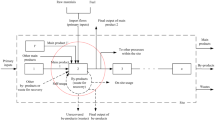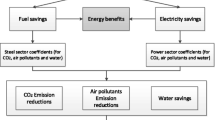Abstract
Incorporating Material Balance Principle (MBP) in industrial and agricultural performance measurement systems with pollutant factors has been on the rise in recent years. Many conventional methods of performance measurement have proven incompatible with the material flow conditions. This study will address the issue of eco-efficiency measurement adjusted for pollution, taking into account materials flow conditions and the MBP requirements, in order to provide ‘real’ measures of performance that can serve as guides when making policies. We develop a new approach by integrating slacks-based measure to enhance the Malmquist Luenberger Index by a material balance condition that reflects the conservation of matter. This model is compared with a similar model, which incorporates MBP using the trade-off approach to measure productivity and eco-efficiency trends of power plants. Results reveal similar findings for both models substantiating robustness and applicability of the proposed model in this paper.


Similar content being viewed by others
Notes
Weak disposability can be written as: \((y, z)\in P(x)\,and\,0 \le \theta \le 1\,imply\,( \theta y, \theta z)\in P(x)\), while free or strong disposability can be defined as: \(( y, z)\in P(x)\,and\,y^{\prime }\le y\,imply\,(y^{\prime }, z)\in P(x)\).
In this case, whereas electricity is the good output and \(\hbox {SO}_{2}\) is the bad one b which is the nutrient coefficient of the good output is 0. Sulfur is not a part of electricity.
In many industries, these types of incentives are imposed to control fuel which consumed and to force the industries to improve their combustion technologies or run them in their best condition.
The third constraint guarantees null jointness property, which is defined as: if \((y, b)\in P(x)\) and \(b=0\) then \(y=0\). Good and bad outputs are produced jointly—see Chung et al. (1997)
In here, the technology is assumed to be fixed.
Here, we can omit \(\mathop {\sum }\nolimits _{i=1}^I g_{xi} +\mathop {\sum }\nolimits _{j=1}^J g_{yj} +\mathop {\sum }\nolimits _{k=1}^K g_{bk} =1\), which does not change the frontier, but plays the role of a scaling constraint to keep inefficiency variable, \(\theta \), within the limit of [0,1].
\(a_{1}=-1.86610\hbox {E}{-}06\hbox { Tone/Cal}\) and \(a_{2}=-6.84500\hbox {E}{-}06\hbox { Tone/Cal}\). See Result of the Comprehensive Plan of Tehran Air Pollution Control, 1997, by JICA and Municipality of Tehran.
References
Arabi, B., Munisamy, S., & Emrouznejad, A. (2015). A new slacks-based measure of Malmquist–Luenberger index in the presence of undesirable outputs. Omega, 51, 29–37.
Arabi, B., Munisamy, S., Emrouznejad, A., & Shadman, F. (2014). Power industry restructuring and eco-efficiency changes: A new slacks-based model in Malmquist–Luenberger Index measurement. Energy Policy, 68, 132–145.
Ayres, R. U., & Kneese, A. V. (1969). Production, consumption, and externalities. The American Economic Review, 59(3), 282–297.
Banker, R. D., Charnes, A., & Cooper, W. W. (1984). Some models for estimating technical and scale inefficiencies in data envelopment analysis. Management Science, 30(9), 1078–1092.
Baumgärtner, S., Dyckhoff, H., Faber, M., Proops, J., & Schiller, J. (2001). The concept of joint production and ecological economics. Ecological Economics, 36(3), 365–372.
Berg, S. A., Førsund, F. R., & Jansen, E. S. (1992). Malmquist indices of productivity growth during the deregulation of Norwegian banking, 1980–89. The Scandinavian Journal of Economics, 94, 211–228.
Bilsel, M., & Davutyan, N. (2014). Hospital efficiency with risk adjusted mortality as undesirable output: the Turkish case. Annals of Operations Research, 221(1), 73–88.
Briec, W. (1997). A graph-type extension of Farrell technical efficiency measure. Journal of Productivity Analysis, 8(1), 95–110.
Burnett, R. D., & Hansen, D. R. (2008). Ecoefficiency: Defining a role for environmental cost management. Accounting, Organizations and Society, 33(6), 551–581.
Charnes, A., Cooper, W., & Rhodes, E. (1978). Measuring the efficiency of decision making units. European journal of operational research, 2(6), 429–444.
Chung, Y. H., Färe, R., & Grosskopf, S. (1997). Productivity and undesirable outputs: A directional distance function approach. Journal of Environmental Management, 51(3), 229–240.
Coelli, T., Lauwers, L., & Huylenbroeck, G. (2007). Environmental efficiency measurement and the materials balance condition. Journal of Productivity Analysis, 28(1–2), 3–12.
Diabat, A., Shetty, U., & Pakkala, T. (2013). Improved efficiency measures through directional distance formulation of data envelopment analysis. Annals of Operations Research, 229(1), 1–22.
Emrouznejad, A. (2014). Advances in data envelopment analysis. Annals of Operations Research, 214(1), 1–4.
Emrouznejad, A., Parker, B. R., & Tavares, G. (2008). Evaluation of research in efficiency and productivity: A survey and analysis of the first 30 years of scholarly literature in DEA. Socio-Economic Planning Sciences, 42(3), 151–157.
Färe, R., & Grosskopf, S. (2010a). Directional distance functions and slacks-based measures of efficiency. European journal of operational research, 200(1), 320–322.
Färe, R., & Grosskopf, S. (2010b). Directional distance functions and slacks-based measures of efficiency: Some clarifications. European Journal of Operational Research, 206(3), 702.
Fare, R., Grosskopf, S., Lovell, C. A. K., & Pasurka, C. (1989). Multilateral productivity comparisons when some outputs are undesirable: A nonparametric approach. The Review of Economics and Statistics, 71(1), 90–98.
Färe, R., Grosskopf, S., Noh, D.-W., & Weber, W. (2005). Characteristics of a polluting technology: Theory and practice. Journal of Econometrics, 126(2), 469–492.
Färe, R., Grosskopf, S., & Pasurka, C, Jr. (2013). Joint production of good and bad outputs with a network application. In Encyclopedia of Energy, Natural Resources and Environmental Economics.
Färe, R., Grosskopf, S., & Pasurka, J. C. A. (2007). Environmental production functions and environmental directional distance functions. Energy, 32(7), 1055–1066.
Färe, R., Grosskopf, S., & Tyteca, D. (1996). An activity analysis model of the environmental performance of firms—application to fossil-fuel-fired electric utilities. Ecological Economics, 18(2), 161–175.
Farrell, M. J. (1957). The measurement of productive efficiency. Journal of the Royal Statistical Society Series A (General), 120(3), 253–290.
Field, B. C. (1994). Environmental Economics. An Introduction. Economics Series. New York: Mc Graw Hill.
Field, B., & Olewiler, N. (2005). Environmental Economics (Updated second Canadian edition). Whitby: McGraw-Hill Ryerson Limited.
Golany, B., Roll, Y., & Rybak, D. (1994). Measuring efficiency of power plants in Israel by data envelopment analysis. IEEE Transactions on Engineering Management, 41(3), 291–301.
Hadi Vencheh, A., Kazemi Matin, R., & Tavassoli Kajani, M. (2005). Undesirable factors in efficiency measurement. Applied Mathematics and Computation, 163(2), 547–552.
Huang, X., Hu, D., & Zhou, Z. (2013). Measuring efficiency in Chinese commercial banks using a DEA model with undesirable output. International Journal of Information and Decision Sciences, 5(2), 140–153.
Jahanshahloo, G. R., Lotfi, F. H., Shoja, N., Tohidi, G., & Razavyan, S. (2005). Undesirable inputs and outputs in DEA models. Applied Mathematics and Computation, 169(2), 917–925.
Khoshroo, A., Mulwa, R., Emrouznejad, A., & Arabi, B. (2013). A non-parametric Data Envelopment Analysis approach for improving energy efficiency of grape production. Energy, 63, 189–194.
Korhonen, P. J., & Luptacik, M. (2004). Eco-efficiency analysis of power plants: An extension of data envelopment analysis. European Journal of Operational Research, 154(2), 437–446.
Kuosmanen, N., & Kuosmanen, T. (2013). Modeling cumulative effects of nutrient surpluses in agriculture: A dynamic approach to material balance accounting. Ecological Economics, 90, 159–167.
Lauwers, L. (2009). Justifying the incorporation of the materials balance principle into frontier-based eco-efficiency models. Ecological Economics, 68(6), 1605–1614.
Lauwers, L., Van Huylenbroeck, G., & Rogiers, G. (1999). Technical, economic and environmental efficiency analysis of pig fattening farms. In Poster presentation at the 9th European Congress of Agricultural Economists, Warschau. Polen, August 24th–28th.
Lozano, S., Gutiérrez, E., & Moreno, P. (2013). Network DEA approach to airports performance assessment considering undesirable outputs. Applied Mathematical Modelling, 37(4), 1665–1676.
Munisamy, S., & Arabi, B. (2015). Eco-efficiency Change in power plants: Using a slacks-based measure for the meta-frontier Malmquist Luenberger productivity index. Journal of Cleaner Production, 105, 218–232.
Murty, S., Robert Russell, R., & Levkoff, S. B. (2012). On modeling pollution-generating technologies. Journal of Environmental Economics and Management, 64(1), 117–135.
Pethig, R. (2006). Non-linear production, abatement, pollution and materials balance reconsidered. Journal of Environmental Economics and Management, 51(2), 185–204.
Picazo-Tadeo, A. J., Reig-Martínez, E., & Hernández-Sancho, F. (2005). Directional distance functions and environmental regulation. Resource and Energy Economics, 27(2), 131–142.
Podinovski, V. (2004). Production trade-offs and weight restrictions in data envelopment analysis. Journal of the Operational Research Society, 55(12), 1311–1322.
Ramli, N. A., Munisamy, S., & Arabi, B. (2013). Scale directional distance function and its application to the measurement of eco-efficiency in the manufacturing sector. Annals of Operations Research, 211(1), 1–18.
Reinhard, S., Knox Lovell, C. A., & Thijssen, G. J. (2000). Environmental efficiency with multiple environmentally detrimental variables; estimated with SFA and DEA. European Journal of Operational Research, 121(2), 287–303.
Seiford, L. M. (1996). Data envelopment analysis: The evolution of the state of the art (1978–1995). Journal of Productivity Analysis, 7(2), 99–137.
Shephard, R. W., Gale, D., & Kuhn, H. W. (1970). Theory of cost and production functions. Princeton, NJ: Princeton University Press.
Thanh Nguyen, T., Hoang, V. N., & Seo, B. (2012). Cost and environmental efficiency of rice farms in South Korea. Agricultural Economics, 43(4), 369–378.
Tone, K. (2001). A slacks-based measure of efficiency in data envelopment analysis. European Journal of Operational Research, 130(3), 498–509.
Tyteca, D. (1997). Linear programming models for the measurement of environmental performance of firms-concepts and empirical results. Journal of Productivity Analysis, 8(2), 183–197.
Utlu, Z., & Kincay, O. (2013). An assessment of a pulp and paper mill through energy and exergy analyses. Energy, 57, 565–573.
Van der Hamsvoort, C. P. C. M., & Latacz-Lohmann, U. (1998). Sustainability: A review of the debate and an extension. International Journal of Sustainable Development and World Ecology, 5, 99–110.
Wei, Y.-M., Liao, H., & Fan, Y. (2007). An empirical analysis of energy efficiency in China’s iron and steel sector. Energy, 32(12), 2262–2270.
Welch, E., & Barnum, D. (2009). Joint environmental and cost efficiency analysis of electricity generation. Ecological Economics, 68(8–9), 2336–2343.
Yang, C.-C. (2014). An enhanced DEA model for decomposition of technical efficiency in banking. Annals of Operations Research, 214(1), 167–185.
Zhou, G., Chung, W., & Zhang, X. (2013). A study of carbon dioxide emissions performance of China’s transport sector. Energy, 50, 302–314.
Zhou, P., Poh, K. L., & Ang, B. W. (2007). A non-radial DEA approach to measuring environmental performance. European Journal of Operational Research, 178(1), 1–9.
Author information
Authors and Affiliations
Corresponding author
Rights and permissions
About this article
Cite this article
Arabi, B., Doraisamy, S.M., Emrouznejad, A. et al. Eco-efficiency measurement and material balance principle: an application in power plants Malmquist Luenberger Index. Ann Oper Res 255, 221–239 (2017). https://doi.org/10.1007/s10479-015-1970-x
Published:
Issue Date:
DOI: https://doi.org/10.1007/s10479-015-1970-x




